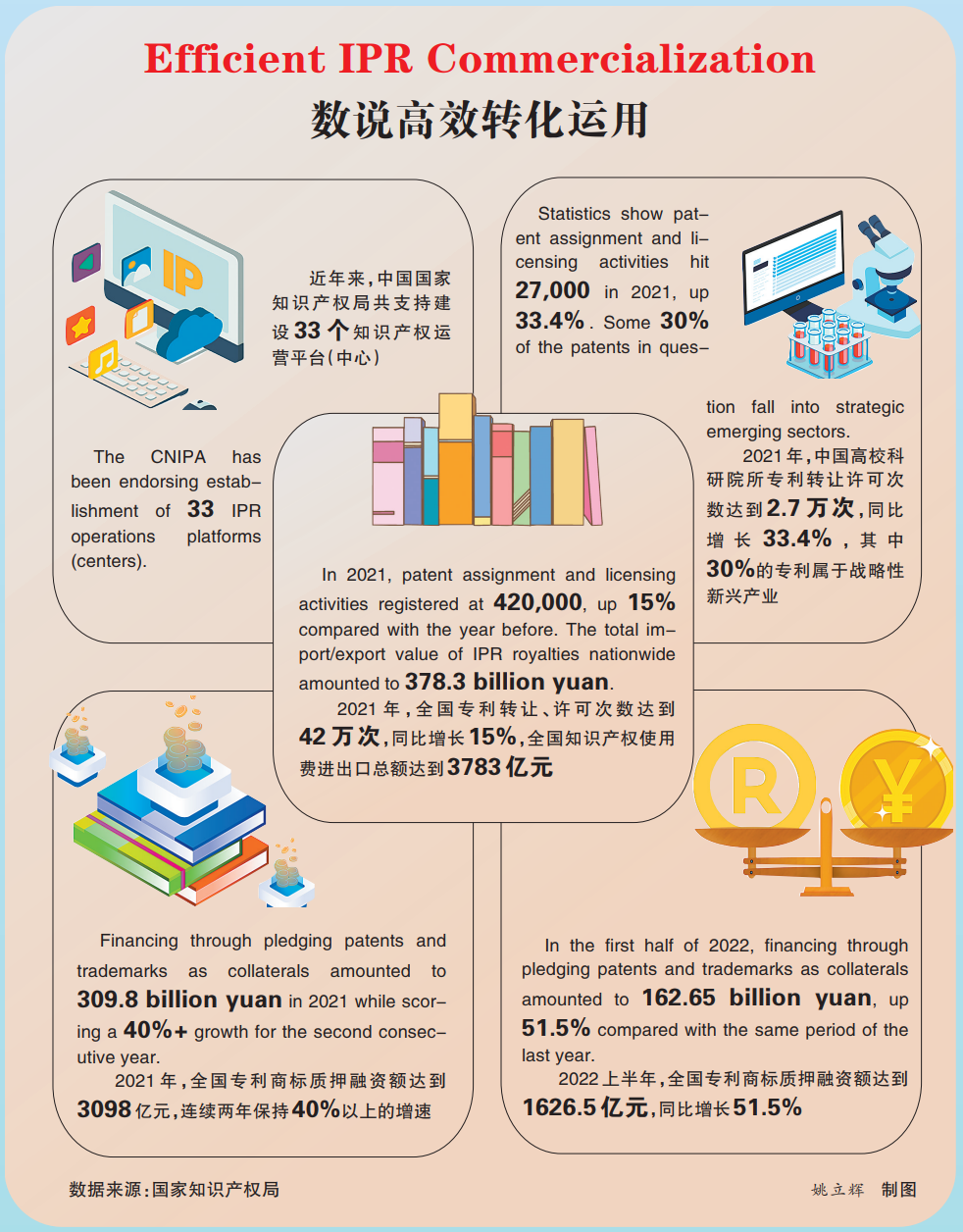Concrete Measures Uplifts IP Commercialization to New Heights
"Efficient transactions of IPRs fuel orderly circulation of innovative resources and elements as well as optimization of configurations while speeding up the release of innovative energy," Heng Fuguang, spokesperson and deputy director general of the China National Intellectual Property Administration (CNIPA) announced at a press conference on IPR commercialization and use in Beijing on August 24, "We are obviously seeing more dynamic IPR transactional activities on top of faster release of innovative energy. Financial packages serving IPRs inject capital to market players, lending robust support to their monetary needs. Benefits generated by IPR use also booms, exerting a more pronounced role in assisting quality development of economy."
Principals from the CNIPA's promotion of IPR use department, science/technology and information technology department of the Ministry of Education (MOE), science/technology department of the Ministry of Industry and Information Technology, laws and regulations department of the China Banking and Insurance Regulatory Commission (CBIRC) attended the press conference revealing the latest developments and achievements of IPR commercialization and use.
Boom of IPR operations
In 2021, patent assignment and licensing activities registered at 420,000, up 15% compared with the year before. The total import/export value of IPR royalties nationwide amounted to 378.3 billion yuan with the growth rate of export hitting 27.1%, 10.5 percentage points higher than that of import, painting a scenario "simultaneous growth of both export and import while export prevails".
According to Lei Xiaoyun, director general of the CNIPA's promotion of IPR use department, the CNIPA has been building an IPR operation system by endorsing establishment of 33 IPR operations platforms (centers), which brings together IPR buyers and sellers, and provide support for deals and transactions. The CNIPA also partnered with the Ministry of Finance (MOF) in building operations platforms, rearing institutes, allocating funds and executing programs in key cities.
Lei also brought attention to some specific programs done by the CNIPA, such as refinement of the IPR evaluation system, design of a national standard for patent evaluation, continued publication of statistics on patent royalty rates of recorded licensing agreements and formation of a system detecting prices of IPR deals. The CNIPA also joined hands with the MOF to implement a special program on patent commercialization while demanding local administrations to bond patent open-licensing pilot programs with patent commercialization programs and to integrate with IPR operations of universities and enterprises.
Patent commercialization surging at universities and research institutes
Even when IPR transactions are generally very dynamic in China, patent commercialization at universities and research institutes still stands out with their rapid growth. Statistics show patent assignment and licensing activities hit 27,000 last year, up 33.4% - a rate head and shoulders above the averages of all other types of innovators. Some 30% of the patents in question fall into strategic emerging sectors, becoming "the source of running water" for commercialization of high-value patents.
Lei Chaozi, director general of the MOE's science/technology and information technology department said his ministry has invoked two tools to accelerate transformation of universities' scientific and technological findings to real-world productivity, namely "upgrading quality of research findings" and "strengthening policy incentives". Regarding "upgrading quality of research findings", the MOE stresses whether the findings have catered the needs of industry and enterprise production and solved the outstanding problems bothering enterprises. Regarding "strengthening policy incentives", most universities have raised their compensation percentage to 70% while some even adopt an over 90% rate.
IPR financing bringing "real money"
"Although the economy softened in the first half of the year, financing through pledging patents and trademarks as collaterals amounted to 162.65 billion yuan, up 51.5% compared with the same period of the last year. Among all projects, the number of generalized preferential projects with loan cap under 10 million yuan reached 7,345, up 112% and effectively easing the financial worries of a raft of SMEs," Heng said measures like financing through pledging IPRs, operations funds, securitization effectively provides capital security for market players, giving its share of contributions to the central government's objectives in achieving social security.
Financing through pledging patents and trademarks as collaterals amounted to 309.8 billion yuan in 2021 while scoring a 40%+ growth for the second consecutive year. What is behind the feat is constant optimization and upgrade of the relevant service system and capacity. Li Hanyang, director general of the CBIRC's laws and regulations department said its satellite offices issued support policies with relevant agencies on financing through pledging IPRs. Some banks voluntarily reached out to IPR administrations, concluded comprehensive strategic cooperation agreements with them, and set up joint innovation labs dedicated to the cause while commercial banks were encouraged to make "bold and willing" decisions when lending loans.

Source:China IP News



